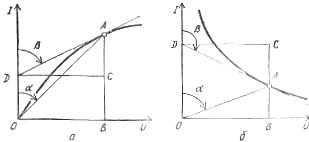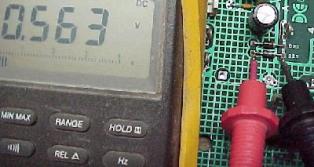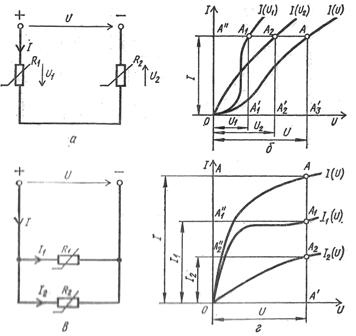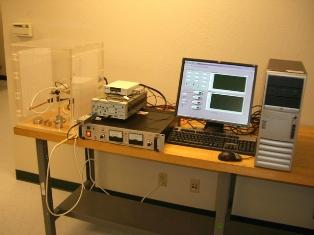Nonlinear electrical circuits
Purpose of non-linear elements in electrical circuits
V electrical circuits may include passive elements, electrical resistance which essentially depends on the current or the stress, with the result that the current is not directly proportional to the voltage. Such elements and the electric circuits in which they enter are called non-linear elements.
Nonlinear elements give electrical circuits properties unattainable in linear circuits (voltage or current stabilization, DC amplification, etc.). They are uncontrollable and controlled... The first — bipolar — is designed to work without the influence of a control factor on them (semiconductor thermistors and diodes), and the second — multipolar — is used when a control factor acts on them (transistors and thyristors).
Current-voltage characteristics of nonlinear elements
The electrical properties of nonlinear elements are current-voltage characteristics I (U) experimentally obtained graphs showing the dependence of current on voltage, for which an approximate, convenient for calculation empirical formula is sometimes made.
Uncontrolled nonlinear elements have a single current-voltage characteristic, and controlled nonlinear elements have a family of such characteristics whose parameter is the controlling factor.
Linear elements have a constant electrical resistance, so their current-voltage characteristic is a straight line passing through the origin (Fig. 1, a).
The current-voltage characteristics of nonlinear have a different shape and are divided into symmetric and asymmetric with respect to the coordinate axes (Fig. 1, b, c).

Rice. 1. Current-voltage characteristics of passive elements: a — linear, b — nonlinear symmetric, c — nonlinear asymmetric

Rice. 2. Graphs for determining the static to differential resistance of non-linear elements in the sections of the current-voltage characteristics: a — rising, b — falling
For non-linear elements with a symmetrical current-voltage characteristic or for symmetrical elements, a change in the voltage direction does not cause a change in the current value (Fig. 1, b), and for non-linear elements with an asymmetric voltage-current characteristic, or for asymmetric elements, with one and the same absolute value of the voltage directed in opposite directions, the currents are different (Fig. 1, c). Therefore, nonlinear symmetrical elements are used in DC and AC circuits, and nonlinear unbalanced elements, as a rule, in AC circuits to convert AC into DC current.
Characteristics of nonlinear elements
For each non-linear element, a static resistance corresponding to a given point of the current-voltage characteristic is distinguished, for example point A:
Rst = U / I = muOB / miBA = mr tgα
and the differential resistance which is for. the same point A is determined by the formula:
Rdiff = dU / dI = muDC / miCA = mr tgβ,
where mi, mi, sir — respectively the scale of voltages, currents and resistances.
The static resistance characterizes the properties of a non-linear element in the constant current mode, and the differential resistance — for small deviations of the current from the steady state value. Both change when passing from one point and the current-voltage characteristic to another, the first being always positive and the second variable: in the rising section of the characteristic, the current-voltage is positive, and in the falling section it is negative.
Nonlinear elements are also characterized by reciprocal values: static conductivity Gst and differential conductivity Gdifferent or dimensionless parameters —
relative resistance:
Kr = — (Rdifference /Rst)
or relative conductivity:
Kg = — (Gdifference / Gst)
Linear elements have parameters Kr and Kilogram equal to one, and for non-linear elements they differ from it, and the more they differ from one, the more the nonlinearity of the electrical circuit is manifested.
 Calculation of non-linear electrical circuits
Calculation of non-linear electrical circuits
Nonlinear electrical circuits are calculated graphically and analytically based on Kirchhoff's laws and volt-ampere characteristics of individual elements of alternating current circuits for converting alternating current to direct current.
When graphically calculating an electric circuit with two series-connected nonlinear resistors R1 and R2 with current-voltage characteristics Iz (U1) and Iz (U2), build the current-voltage characteristic of the entire circuit Iz (U), where U = U1 + U2, the abscissas of the points of which are found by summing the abscissas of the points of the current-voltage characteristics of nonlinear resistors with equal ordinates (Fig. 3, a, b).

Rice. 3. Diagrams and characteristics of non-linear electrical circuits: a — circuit of series connection of non-linear resistors, b — volt-ampere characteristics of individual elements and series circuit, c — scheme of parallel connection of non-linear resistors, d — volt-ampere characteristics of individual elements and a parallel circuit.
The presence of this curve allows the voltage U to find the current Az as well as the voltage U1 and U2 at the terminals of the resistors.
In the same way, the calculation of the electric circuit with two resistors connected in parallel is carried out. R1 and R2 with current-voltage characteristics I1 (U) and Az2 (U), for which the current-voltage characteristic of the entire circuit Az(U) was built, where Az = I1+I2, on which, using a given voltage U, find currents Az , I1, I2 (oriz. 3, c, d).
The analytical method for calculating non-linear electric circuits is based on the presentation of the voltage characteristics of the non-linear elements through the equations of the corresponding mathematical functions, which make it possible to draw up the necessary equations of state for the electric circuits.Since the solution of such nonlinear equations often causes significant difficulties, the analytical method for calculating nonlinear circuits is convenient when the operating sections of the current-voltage characteristics of nonlinear elements can be straightened. This allows you to describe the electrical state of the circuit by linear equations that do not create difficulties in solving them.
Fundamentals of Electrical Engineering:
On potential difference, electromotive force and voltage
Electric current in liquids and gases
Electrical resistance of wires
Magnetism and Electromagnetism
About the magnetic field, solenoids and electromagnets
Self induction and mutual induction
Electric field, electrostatic induction, capacitance and capacitors
What is alternating current and how does it differ from direct current

